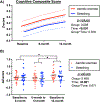Aerobic exercise training and neurocognitive function in cognitively normal older adults: A one-year randomized controlled trial
- PMID: 35713933
- PMCID: PMC9588521
- DOI: 10.1111/joim.13534
Aerobic exercise training and neurocognitive function in cognitively normal older adults: A one-year randomized controlled trial
Abstract
Background: Current evidence is inconsistent on the benefits of aerobic exercise training for preventing or attenuating age-related cognitive decline in older adults.
Objective: To investigate the effects of a 1-year progressive, moderate-to-high intensity aerobic exercise intervention on cognitive function, brain volume, and cortical thickness in sedentary but otherwise healthy older adults.
Methods: We randomized 73 older adults to a 1-year aerobic exercise or stretching-and-toning (active control) program. The primary outcome was a cognitive composite score calculated from eight neuropsychological tests encompassing inductive reasoning, long-term and working memory, executive function, and processing speed. Secondary outcomes were brain volume and cortical thickness assessed by MRI, and cardiorespiratory fitness measured by peak oxygen uptake (VO2 ).
Results: One-year aerobic exercise increased peak VO2 by ∼10% (p < 0.001) while it did not change with stretching (p = 0.241). Cognitive composite scores increased in both the aerobic and stretching groups (p < 0.001 for time effect), although no group difference was observed. Total brain volume (p < 0.001) and mean cortical thickness (p = 0.001) decreased in both groups over time, while the reduction in hippocampal volume was smaller in the stretching group compared with the aerobic group (p = 0.040 for interaction). Across all participants, improvement in peak VO2 was positively correlated with increases in cognitive composite score (r = 0.282, p = 0.042) and regional cortical thickness at the inferior parietal lobe (p = 0.016).
Conclusions: One-year aerobic exercise and stretching interventions improved cognitive performance but did not prevent age-related brain volume loss in sedentary healthy older adults. Cardiorespiratory fitness gain was positively correlated with cognitive performance and regional cortical thickness.
Keywords: aerobic exercise; aging; brain volume and cortical thickness; cardiorespiratory fitness; neurocognitive function.
© 2022 The Association for the Publication of the Journal of Internal Medicine.
Conflict of interest statement
Conflict of interest
None
Figures





References
-
- Amanatkar HR, Papagiannopoulos B, Grossberg GT. Analysis of recent failures of disease modifying therapies in Alzheimer’s disease suggesting a new methodology for future studies. Expert Rev Neurother 2017; 17: 7–16. - PubMed
-
- Shatenstein B, Barberger-Gateau P, Mecocci P. Prevention of Age-Related Cognitive Decline: Which Strategies, When, and for Whom? J Alzheimers Dis 2015; 48: 35–53. - PubMed
-
- Norton S, Matthews FE, Barnes DE, Yaffe K, Brayne C. Potential for primary prevention of Alzheimer’s disease: an analysis of population-based data. Lancet Neurol 2014; 13: 788–94. - PubMed

